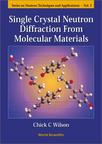分子材料的单晶体中子衍射SINGLE CRYSTAL NEUTRON DIFFRACTION FROM MOLECULAR MATERIALS
出版时间:2000-12 出版社:东南大学出版社 作者:Wilson, Chick C. 页数:370
内容概要
This important book presents a comprehensive account of the techniques and applicationsof single crystal neutron diffraction in the area of chemical crystallography and molecularstructure. Beginning with a brief description of the general principles and the reasonsfor choosing the technique -- the "why" -- the book covers the methods for both theproduction of neutrons and the measurement of their scattering by molecular crystals-- the "how" -- followed by a detailed survey of past, present and future applications-- the "what". The coverage of both steady state and pulsed neutron sources andinstrumentation is extensive, while the survey of applications is the most comprehensiveyet undertaken. The book endeavours to show why the technique is an essential methodfor studying areas as diverse as hydrogen bonding and weak interactions, organometallics,supramolecular chemistry and crystal engineering, metal hydrides, charge density andpharmaceuticals. It is an ideal reference source for the research worker interested inusing neutron diffraction to study the structure of molecules.
书籍目录
ForewordAcknowledgementsCrystallography and the Importance of Structural Information 1.1 Single crystal diffraction - the basics 1.1.1 The crystal 1.1.2 The diffraction pattern 1.1.3 Measuring the diffraction pattern 1.1.4 Defining the molecular structure 1.2 Thermal motion and disorder in crystallography 1.2.1 Good crystallographic order 1.2.2 Thermal vibrational disorder 1.2.3 Static disorder 1.2.4 Thermal parameters and their chemical and physical importance 1.3 Chemical information from neutron crystallography 1.3.1 Examples 1.3.2 Areas of impact 1.3.3 Hydrogen bonding interactions 1.4 Biology - structure and function 1.5 Practical aspects of single crystal neutron diffraction experiments 1.5.1 Obtaining the sample 1.5.2 Collecting the data 1.5.3 Data resolution - desired and accessible 1.5.4 Solving the structure 1.5.5 Completing the structure - Fourier maps 1.5.6 Refining the structure 1.6 Summary 1.7 References2 Neutron Scattering 2.1 Neutrons and their characteristics 2.2 Neutron production 2.2.1 The development of reactor sources 2.2.2 The development of spallation sources 2.3 The characteristics of neutron sources 2.3.1 Reactor sources 2.3.2 Spallation sources 2.3.3 Moderation 2.4 Two neutron sources 2.4.1 The ILL reactor source 2.4.2 The ISIS pulsed spallation neutron source 2.5 Neutron detection 2.5.1 Gas detectors 2.5.2 Scintillator detectors 2.5.3 Area neutron detectors 2.5.4 Image plates and Charge Coupled Devices (CCDs) 2.6 The complementarity of X-rays and neutrons in single crystal diffraction 2.6.1 Joint X-ray and neutron methods 2.6.2 Joint X+N refinements 2.6.3 The accuracy of X-ray and neutron determinations 2.6.4 Improving joint determinations: non-spherical X-ray formfactors 2.6.5 Multipole refinement of X-ray data 2.6.6 Requirements for successful studies using both X-ray andneutron data 2.7 Other methods in neutron scattering 2.8 References3 Techniques for Single Crystal Neutron Diffraction 3.1 Single crystal diffractometers 3.1.1 Basic principles of single crystal diffractometers. 3.1.2 Automatic diffractometry 3.2 Data collection and intensity extraction 3.2.1 Basic procedures for single crystal data collection 3.2.2 Choice of scans for data collection 3.2.3 Peak Integration 3.2.4 Over-determination of data sets 3.3 Data reduction and correction 3.3.1 Normalisation 3.3.2 Absorption corrections ……4 Review of Applications Ⅰ:the accurate Location of Atoms5 Review of Applications Ⅱ:Hydrogen Bonding and other6 Review of Applications Ⅲ:Probing Vibrations and Disorder7 Impact on Material properties and Design8 The Future:New Instruments,New sources,New Techniques,New scienceAppendix Ⅰ.Absorption coefficients used in single crystal neutron diffraction experiments Appendix Ⅱ.Analyses of the librations of terminal groupsIndex
图书封面
评论、评分、阅读与下载
分子材料的单晶体中子衍射SINGLE CRYSTAL NEUTRON DIFFRACTION FROM MOLECULAR MATERIALS PDF格式下载
用户评论 (总计0条)
推荐图书
- 建筑结构施工问答
- 证券法,,2006法令增补本Securities Regulation 2006 Statutory Supplement
- 日本经济JAPANESE ECONOMY
- 亚太地区的企业家ENTREPRENEURSHIP IN PACIFIC ASIA
- 商业与社会宏观经济
- 正常经济理论/THEORY OF REGULAR ECONOMIES
- 造谣惑众的品牌
- 老照片(第55辑)
- 猫王/Elvis
- 马克思主义政治哲学
- 市场营销学
- 网络营销师岗位职业技能培训教程
- 市场调查与分析
- 营销科学学报
- 汽车营销师培训教程
- 车载祈福大悲咒佛曲
- 胆囊炎与胆结石简便自疗
- 数字逻辑基础与Verilog设计
- 神箭凌霄
- 中国文学批评史新编(上、下卷)
- TCD-3160 天使宝贝胎教音乐(2)(CD)
- 会计电算化实训与实验
- Pro/ENGINEER Wildfire 3.0综合培训教程
- 公路工程施工进度控制
- 科学的前沿
相关图书
- 基本拓扑学及应用ELEMENTARY TOPOLOGY AND APPLICATIONS
- 计算数学及力学随机变量的适应性方法ADAPTIVE METHODS OF COMPUTING MATHEMATICS
- 统计物理学
- 纳米多孔材料
- 热致发光手册HANDBOOK OF THERMOLUMINESCENCE
- Applied Mathematics Reviews (精装)
- 物理学中的几何相位GEOMETRIC PHASES IN PHYSICS
- 企业债权保护
- 期权理论与公司理财
- 公司理财学习指导
- 内部控制理论结构
- 宝贝计划电影原声大碟(CD)
- 公司财务管理基础
- 建
- 抹灰工技能
- 混凝土工-(初级)(3VCD)
- 给水排水工程设计实践教程
- 5 69708 2 LES…(著名大提琴家富尼埃作品专辑…)(CD)
- 新编实用粤语教程
- 成人简易钢琴名曲66首
- 美学基础与幼儿美育
- Pro/ENGINEER Wildfire 3.0应用与实例教程
- 我国流域跨界水污染纠纷协调机制研究
- 电子商务概论
- 公关共和国
